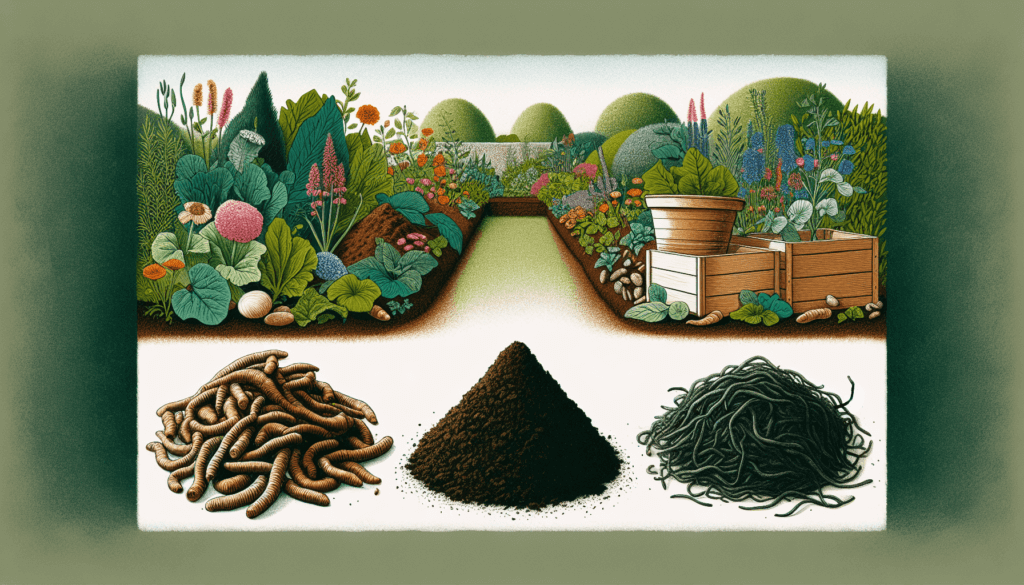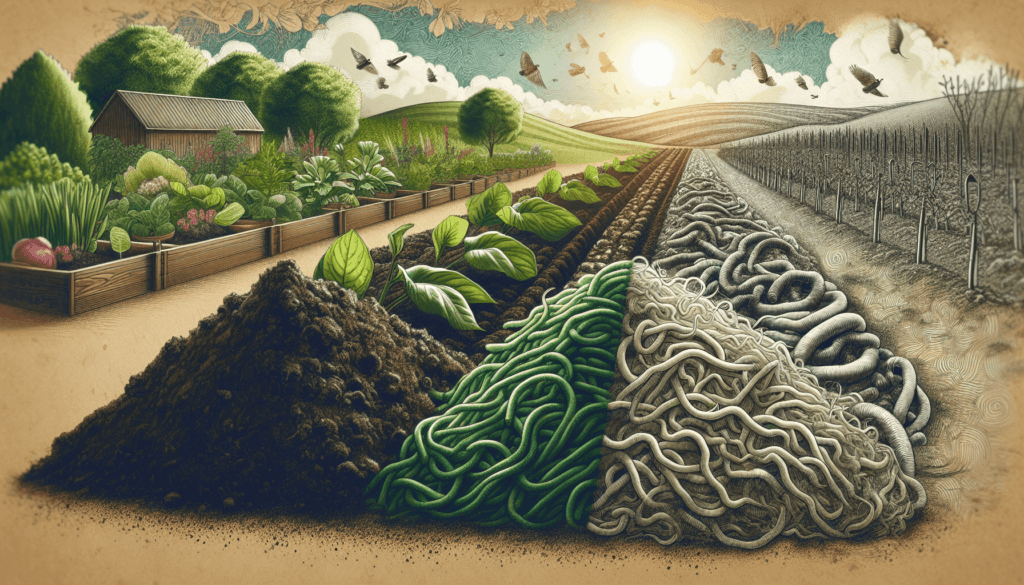Are you looking to take your gardening to the next level? If so, then you’ve come to the right place. In this article, we will explore the best organic fertilizers available that will not only enhance the health and vitality of your plants but also contribute to sustainable gardening practices. From natural plant-based options to nutrient-rich compost, we will delve into the world of organic fertilizers and provide you with the essential information you need to cultivate a thriving and eco-friendly garden. So, get ready to discover the secrets to successful sustainable gardening.
Compost
How to make compost
Making compost is a simple and rewarding process that allows you to recycle organic waste and create a nutrient-rich fertilizer for your garden. To make compost, you will need a compost bin or pile, which can be made from materials such as wood, wire, or even repurposed containers.
Start by collecting organic materials such as fruit and vegetable scraps, yard waste like grass clippings and leaves, and coffee grounds. Avoid adding meat, dairy, or oily foods, as they can attract pests. You can also add materials like shredded paper or cardboard to enhance the composting process.
Layer the materials in your compost bin or pile, alternating between green materials (high in nitrogen) and brown materials (high in carbon). Green materials include fresh grass clippings and kitchen scraps, while brown materials include dried leaves and straw. This layering helps create a balanced carbon-to-nitrogen ratio, which is essential for composting.
To accelerate the decomposition process, you can turn the compost regularly to promote aeration and mix the materials. This ensures that the bacteria and fungi responsible for breaking down the organic matter can thrive. Keep the compost moist, but not overly wet, as excessive moisture can hinder decomposition.
Over time, the organic materials will break down into dark, crumbly compost, which can be used as an excellent fertilizer for your plants. It is recommended to let the compost mature for a few months to allow any remaining organic matter to break down fully. You can then use your homemade compost to enrich the soil in your garden beds or containers.
Benefits of using compost as fertilizer
Using compost as fertilizer offers numerous benefits for your plants and the environment. Compost is a natural and organic way of enriching your soil, providing essential nutrients, improving soil structure, and promoting healthy plant growth.
One of the key benefits of compost is its ability to improve soil structure. By adding compost to your soil, you enhance its ability to retain moisture, aerate, and drain excess water effectively. This is especially beneficial for clay or sandy soils, which tend to have poor drainage or water retention capabilities.
Compost is also rich in nutrients, such as nitrogen, phosphorus, and potassium, which are essential for plant growth. These nutrients are released gradually into the soil, providing a steady and balanced supply for your plants. Additionally, compost contains a range of micronutrients that are necessary for healthy plant development.
Furthermore, using compost as fertilizer helps promote soil biodiversity. Compost is teeming with beneficial microorganisms, such as bacteria and fungi, that contribute to a healthy soil ecosystem. These microorganisms break down organic matter further and help release nutrients for plant uptake. A diverse and thriving soil ecosystem leads to healthier plants and reduces the need for chemical fertilizers.
In addition to its benefits for plants, composting also reduces the amount of organic waste that ends up in landfills, reducing methane emissions and contributing to a more sustainable environment. By making composting a part of your gardening routine, you are actively participating in the circular economy and reducing your carbon footprint.
Types of compost
There are various types of compost you can make, each suited for different gardening needs. Here are a few examples:
-
General Purpose Compost: This is the most common type of compost, made by combining a mixture of kitchen scraps, yard waste, and other organic matter. It provides a well-rounded source of nutrients for most plants.
-
Seed Starting Mix: This compost is designed specifically for germinating seeds and promoting healthy seedling growth. It is usually lighter in texture and may contain perlite or vermiculite for improved drainage and aeration.
-
Potting Mix: Potting mix compost is specially formulated to be used in containers and raised beds. It typically contains a blend of compost, peat moss, and other organic materials to provide a lightweight, well-draining medium for potted plants.
-
Acid-Loving Compost: Some plants, such as azaleas and blueberries, prefer acidic soil conditions. Acid-loving compost is made by incorporating pine needles, coffee grounds, and other acidic materials into the compost mix.
Tailoring your compost to meet the specific needs of your plants can help optimize their growth and overall health.
Manure
Types of manure
Manure is a popular organic fertilizer that has been used for centuries to improve soil fertility and enhance plant growth. There are several types of manure available, and each has its own unique characteristics and benefits.
-
Cow Manure: Cow manure is one of the most commonly used types of manure. It is relatively low in nitrogen but contains a good balance of other essential nutrients like phosphorus and potassium. Cow manure is a great all-purpose fertilizer suitable for a wide range of plants.
-
Horse Manure: Horse manure is similar to cow manure in terms of nutrient composition. However, horse manure often contains more weed seeds due to the horses’ diet. It is advisable to compost horse manure thoroughly before using it as fertilizer to prevent weed growth.
-
Chicken Manure: Chicken manure is high in nitrogen and is considered a “hot” manure, meaning it can release high levels of ammonia during decomposition. It is best to compost chicken manure before using it as fertilizer to avoid burning plant roots.
-
Sheep Manure: Sheep manure is another excellent organic fertilizer option. It has a balanced nutrient profile and is particularly beneficial for improving soil structure due to its fibrous nature. Sheep manure is often combined with other organic materials for composting.
-
Rabbit Manure: Rabbit manure is rich in essential nutrients and contains a higher percentage of nitrogen compared to other types of manure. It is not as “hot” as chicken manure and can be used directly on plants without composting.
Choose the type of manure that best suits your garden’s needs and availability. Composting manure before use helps reduce the risk of potential pathogens and weed seeds.
How to use manure as fertilizer
When using manure as fertilizer, it is essential to apply it correctly to maximize its benefits and prevent any potential issues. Here are some guidelines for using manure in your garden:
-
Composting: Composting manure before use is highly recommended. Composting not only helps eliminate any potential pathogens or weed seeds but also enhances the nutrient content and makes the manure easier to handle. Add the manure to your compost pile or bin and let it decompose for several months, turning it occasionally to ensure proper aeration.
-
Application Rates: Manure should be applied sparingly to avoid overloading the soil with nutrients. As a general rule, apply about 1-2 inches of composted manure per growing season. For established plants, you can side-dress or top-dress around the base of the plants, avoiding direct contact with the stems or leaves.
-
Mixing with Soil: Prior to planting, mix composted manure into the top few inches of soil. This helps distribute the nutrients evenly and improves soil fertility throughout the root zone.
-
Watering and Mulching: After applying manure, water thoroughly to help activate the release of nutrients into the soil. Mulching the garden beds with a layer of organic material, such as straw or shredded leaves, helps retain moisture and protect the soil from erosion.
-
Crop Rotation: To avoid nutrient imbalances and potential nutrient runoff, practice crop rotation in your garden. This involves planting different crops in different areas each season to allow the soil to replenish and prevent the buildup of specific nutrient deficiencies or excesses.
Using manure as a fertilizer can significantly enhance soil fertility and promote healthy plant growth. Just remember to compost it properly and apply it in moderation to achieve optimal results.

Bone Meal
Benefits of using bone meal
Bone meal is a natural fertilizer made from finely ground animal bones. It is an excellent source of phosphorus and calcium, two essential nutrients for plant growth. Here are some benefits of using bone meal as a fertilizer:
-
Promotes Strong Root Development: Phosphorus is crucial for root development and overall plant growth. Bone meal is rich in phosphorus and helps stimulate root growth, making it especially beneficial for young plants and seedlings.
-
Enhances Flowering and Fruit Production: Phosphorus plays a key role in the production of flowers and fruits. Adding bone meal to flowering or fruiting plants can encourage more abundant blooms and a higher yield of delicious fruits.
-
Improves Soil Structure: Bone meal contains calcium, which helps improve soil structure by promoting aggregation. This results in better drainage, aeration, and nutrient absorption by the plant roots.
-
Long-Lasting Nutrient Release: Bone meal is a slow-release fertilizer, meaning it provides a steady supply of nutrients over an extended period. This allows plants to access the phosphorus and calcium gradually, ensuring continuous growth and development.
-
pH Adjustment: Bone meal has a slightly alkaline pH, which can help neutralize acidic soils and balance the pH levels. This is beneficial for plants that prefer neutral to slightly alkaline conditions.
How to use bone meal as fertilizer
Using bone meal as fertilizer is relatively straightforward. Here are some guidelines to help you make the most of this natural and nutrient-rich product:
-
Application Rates: Bone meal should be applied at the recommended rates according to the specific product instructions. Generally, a range of 1-3 tablespoons per square foot is suitable for most gardening applications.
-
Incorporation: Before planting, mix bone meal into the soil in the planting hole or bed. Dig a hole or trench that is slightly larger than the root ball or plant spacing, add the appropriate amount of bone meal, and then cover it with a thin layer of soil to prevent direct contact with the roots.
-
Balancing Nutrients: If using bone meal as the sole source of phosphorus in your garden, it is crucial to maintain a proper nutrient balance. Excessive phosphorus can interfere with the uptake of other nutrients like iron and zinc. Consider conducting a soil test to determine the existing nutrient levels and adjust the bone meal application accordingly.
-
Watering and Mulching: After applying bone meal, water the area thoroughly to help activate the nutrients and settle the soil. Apply a layer of organic mulch, such as wood chips or straw, to conserve moisture and protect the soil from erosion.
-
Reapplication: Bone meal is a slow-release fertilizer, but its effectiveness gradually diminishes over time. Reapply bone meal every 3-6 months or as recommended by the product instructions to ensure a consistent supply of phosphorus and calcium for your plants.
Remember to store bone meal in a cool and dry place to maintain its efficacy and prevent any odors or attract pests. By using bone meal as a natural fertilizer, you can promote healthy plant growth and contribute to the overall vitality of your garden.
Fish Emulsion
Benefits of using fish emulsion
Fish emulsion is a popular organic fertilizer made from fish waste, such as bones, skin, and scales. It is a potent source of nitrogen, phosphorus, and trace minerals, making it highly beneficial for plants. Here are some advantages of using fish emulsion as a fertilizer:
-
Fast-Acting Nitrogen Boost: Fish emulsion is rich in nitrogen, a vital nutrient for foliage growth and overall plant vigor. Nitrogen promotes the production of chlorophyll, which is essential for photosynthesis and the development of healthy leaves.
-
Balanced Nutrient Profile: In addition to nitrogen, fish emulsion contains other essential nutrients like phosphorus and potassium. These nutrients contribute to root development, flowering, and fruit production, ensuring a well-rounded supply of plant nutrition.
-
Organic Matter Enrichment: Fish emulsion adds organic matter to the soil, helping improve its structure, moisture retention, and microbial activity. This contributes to a healthy and fertile soil environment, supporting long-term plant health.
-
Beneficial Microbial Activity: Fish emulsion contains beneficial microorganisms, which can aid in breaking down organic matter further and enhancing nutrient availability for plants. These microorganisms contribute to soil biodiversity and overall ecosystem balance.
-
Stimulates Soil Fertility: Regular use of fish emulsion can improve soil fertility over time. The organic matter and nutrients released by fish emulsion contribute to the enrichment of the soil, creating a favorable environment for beneficial soil organisms and promoting sustainable gardening practices.
How to use fish emulsion as fertilizer
Using fish emulsion as a fertilizer is simple and effective. Here’s how you can make the most of this nutrient-rich organic product:
-
Dilution: Fish emulsion is typically a concentrated liquid, and it is necessary to dilute it before application. Follow the product instructions to determine the appropriate dilution ratio for your specific needs. Generally, a dilution ratio of 1:4 or 1:5 (one part fish emulsion to four or five parts water) is suitable for most applications.
-
Application Methods: Fish emulsion can be used as a soil drench or as a foliar spray. For soil application, evenly water the area surrounding the plant, ensuring the soil is moist before applying the fish emulsion. Slowly pour the diluted fish emulsion around the base of the plant, taking care not to splash it onto the leaves. For foliar application, use a sprayer to evenly coat the leaves with the diluted fish emulsion solution.
-
Frequency: Fish emulsion can be applied every 2-4 weeks during the growing season or as recommended by the product instructions. Avoid excessive applications, as too much nitrogen can lead to lush foliage growth at the expense of flowers or fruit production.
-
Storage: Seal the fish emulsion container tightly and store it in a cool and dark place to maintain its quality. Avoid extreme temperature fluctuations, as they can degrade the product. Use the emulsion within the recommended timeframe to ensure maximum potency.
By incorporating fish emulsion into your fertilization routine, you can provide your plants with a nutrient-rich boost and promote healthy growth naturally.

Seaweed
Benefits of using seaweed as fertilizer
Seaweed has long been recognized as a beneficial addition to garden soil and a valuable organic fertilizer. It offers numerous benefits that contribute to healthy plant growth and overall garden vitality. Here are some advantages of using seaweed as a fertilizer:
-
Rich in Micronutrients: Seaweed contains a wide range of essential micronutrients, including magnesium, potassium, calcium, and a variety of trace minerals. These nutrients are vital for plant health and play key roles in various biochemical processes, such as enzyme activation and chlorophyll synthesis.
-
Promotes Root Growth: The natural hormones, cytokinins, and auxins present in seaweed help stimulate root growth and development. Strong root systems improve nutrient uptake, water absorption, and overall plant stability, leading to healthier and more resilient plants.
-
Increases Resistance to Stress: Seaweed contains compounds that enhance a plant’s ability to tolerate and recover from various stressors, such as drought, temperature extremes, and diseases. Regular use of seaweed can increase a plant’s resilience and improve its overall ability to withstand environmental challenges.
-
Enhances Soil Structure: By adding seaweed to the soil, you can improve its structure and water-holding capacity. Seaweed acts as a soil conditioner, helping to break up compacted soil, increase moisture retention, and promote beneficial microbial activity.
-
Balances Soil pH: Seaweed has a naturally alkaline pH, which can help balance acidic soils. If you have plants that prefer more neutral or alkaline conditions, incorporating seaweed into the soil can help adjust the pH and create a more favorable environment for their growth.
How to use seaweed as fertilizer
Seaweed can be used fresh or dried for gardening purposes. Here are some ways you can incorporate seaweed into your fertilizer routine:
-
Fresh Seaweed: If you have access to fresh seaweed, rinse it thoroughly to remove excess salt. Chop or tear the seaweed into smaller pieces for easier handling and incorporation into the soil. Mix the seaweed directly into the soil around your plants, or create a seaweed tea by soaking the seaweed in a bucket of water for a few weeks. Use the strained liquid as a nutrient-rich fertilizer.
-
Dried Seaweed: Dried seaweed is widely available and can be used as a mulch or incorporated directly into the soil. For mulching, spread a layer of dried seaweed around the base of your plants, taking care not to mound it against the stems or trunks. As the seaweed breaks down, it will release its nutrients into the soil. Alternatively, you can grind the dried seaweed into a fine powder and mix it with water to create a liquid fertilizer.
-
Seaweed Extract: Seaweed extract is a concentrated form of seaweed that is typically sold as a liquid or powder. Follow the product instructions for the appropriate dilution ratio, and apply the seaweed extract as a soil drench or foliar spray. Soil drenching involves pouring the diluted extract around the base of the plants, while foliar spraying entails evenly coating the leaves with the diluted solution.
-
Composting: Seaweed can also be added to your compost pile or bin to enhance its nutrient content and accelerate decomposition. Add seaweed along with other organic materials like kitchen scraps and yard waste, and mix the pile occasionally to ensure proper aeration and decomposition.
Seaweed is a valuable resource for gardeners, providing essential nutrients and promoting overall plant health. Whether used fresh, dried, or in the form of an extract, seaweed can significantly contribute to sustainable gardening practices and the long-term fertility of your soil.
Coffee Grounds
Benefits of using coffee grounds as fertilizer
Coffee grounds are a readily available and nutrient-rich organic material that can be used as fertilizer in your garden. Here are some benefits of using coffee grounds:
-
Nitrogen Boost: Coffee grounds are relatively high in nitrogen, making them an excellent source of this essential nutrient for plants. Nitrogen promotes vigorous foliage growth and improves overall plant health.
-
Acidity Adjustment: Coffee grounds are slightly acidic, which can be beneficial for plants that prefer acidic soil conditions. Acid-loving plants, such as azaleas, blueberries, and hydrangeas, can benefit from the natural acidity of coffee grounds.
-
Organic Matter Enrichment: Adding coffee grounds to the soil improves its organic matter content, enhancing soil structure, moisture retention, and microbial activity. This contributes to a healthier soil ecosystem and promotes sustainable gardening practices.
-
Water Retention: Coffee grounds can help improve water retention in sandy or well-draining soils. By incorporating coffee grounds into the soil, you can enhance its ability to hold moisture, providing a more favorable environment for plant roots.
-
Nutrient Release: Coffee grounds release their nutrients slowly over time, providing a steady supply of nitrogen, potassium, and other essential elements. This gradual nutrient release helps support long-term plant growth and reduces the risk of nutrient leaching.
How to use coffee grounds as fertilizer
While coffee grounds are beneficial for plants, it is essential to use them correctly to avoid potential issues. Here’s how you can use coffee grounds as a fertilizer:
-
Composting: Coffee grounds are an excellent addition to your compost pile or bin. Mix them with other organic materials, such as kitchen scraps, yard waste, and dried leaves, to create a balanced compost mix. Coffee grounds help balance the carbon-to-nitrogen ratio in the compost, facilitating decomposition and enriching the resulting compost with essential nutrients.
-
Direct Application: Coffee grounds can be applied directly to the soil around your plants. It is best to mix the coffee grounds with the top few inches of soil to promote even distribution and prevent excessive nitrogen concentration in one area. Avoid piling coffee grounds directly against plant stems or trunks, as this can create a barrier to water and air circulation.
-
Mulching: Use coffee grounds as a mulch by spreading a thin layer around the base of your plants. This helps conserve soil moisture, suppress weed growth, and add organic matter to the soil as the coffee grounds break down. Ensure the layer of coffee grounds is not too thick to avoid water runoff or excessive nitrogen release.
-
Worm Bin Addition: If you have a worm bin or vermicomposting system, coffee grounds can be added as a bedding material. Worms thrive in a mix of organic matter, including coffee grounds, and their gradual decomposition helps create nutrient-rich worm castings.
-
Raised Bed Amendment: When planting in raised beds, mix coffee grounds with the soil before planting. This enhances the organic matter content and nutrient availability, providing a fertile growing environment for your plants.
Remember that coffee grounds should be used in moderation, as excessive quantities can disrupt the pH balance of the soil or lead to nitrogen toxicity. As with any fertilizer, it is advisable to conduct a soil test to determine the existing nutrient levels and adjust the application accordingly.
By using coffee grounds as a natural fertilizer, you can harness their nutrient content and contribute to sustainable gardening practices.

Eggshells
Benefits of using eggshells as fertilizer
Eggshells, often regarded as kitchen waste, can be transformed into a valuable fertilizer for your garden. Here are some benefits of using eggshells as fertilizer:
-
Calcium Enrichment: Eggshells are primarily composed of calcium carbonate, which is an essential nutrient for healthy plant growth. Incorporating eggshells into the soil helps supplement the calcium levels, preventing nutrient deficiencies and promoting strong cell walls in plants.
-
Pest Deterrent: Crushed eggshells can be an effective natural deterrent against certain garden pests. Eggshells have sharp edges that can deter slugs, snails, and other soft-bodied insects from crawling across them, protecting your plants from potential damage.
-
Soil Structure Improvement: By adding eggshells to the soil, you can improve its structure and drainage capabilities. Eggshells help break up compacted soil, promote aeration, and increase water infiltration, creating a favorable environment for plant roots.
-
pH Adjustment: Eggshells have a slightly alkaline pH, which can help neutralize acidic soils. For plants that prefer more neutral or alkaline conditions, incorporating eggshells into the soil can help balance the pH and create a more suitable growing environment.
-
Sustainable Waste Management: Using eggshells as fertilizer is an eco-friendly way to repurpose kitchen waste. Rather than throwing away eggshells, you can recycle them in your garden, reducing waste and minimizing your environmental footprint.
How to use eggshells as fertilizer
To utilize eggshells as fertilizer effectively, follow these guidelines:
-
Crushing: Crush the eggshells into small pieces before incorporating them into the soil. This can be done by hand or by using a mortar and pestle. Crushing the eggshells increases their surface area, allowing them to break down and release nutrients more efficiently.
-
Composting: Eggshells can be added directly to your compost pile or bin. As they decompose, the calcium and other nutrients are gradually released, enriching the resulting compost. The compost can then be used to improve soil fertility throughout your garden.
-
Soil Amendment: Crushed eggshells can be mixed into the soil around your plants. Prior to planting, incorporate the crushed eggshells into the top few inches of soil. This helps distribute the calcium and other nutrients evenly and provides a slow-release fertilizer for your plants.
-
Seedling Starter: For seed starting, finely grind the eggshells into a powder and mix it with the potting mix. The calcium in the eggshells helps prevent calcium deficiency in young plants and promotes strong root development.
-
Pest Control: Crushed eggshells can be sprinkled around the base of plants to deter pests. Concentrate the eggshells in areas prone to slug or snail activity to create a physical barrier that pests are less likely to cross.
Remember that eggshells enhance soil fertility over time and should be used as part of a comprehensive fertilization plan. By repurposing eggshells in your garden, you can provide valuable nutrients to your plants while reducing kitchen waste.
Green Manure
What is green manure
Green manure, also known as cover crops, refers to specific plant species grown specifically to improve soil fertility rather than for harvest. These crops are typically sown in fall or early spring and then tilled or mulched into the soil before they reach maturity. Green manure offers several benefits for gardeners and their soil:
-
Nutrient Accumulation: Green manure plants take up nutrients from the soil and store them in their tissues. When the plants are incorporated into the soil, these nutrients are released, enhancing soil fertility. Different green manure plants have varying nutrient profiles, allowing you to choose the one that best suits your soil needs.
-
Weed Suppression: Dense green manure growth can outcompete weed species, preventing them from establishing and spreading in the garden. The thick canopy created by cover crops shades the soil, limiting weed growth and reducing the need for manual weeding.
-
Erosion Control: Green manure plants have an extensive root system that helps bind the soil particles together, reducing erosion. Their above-ground growth also acts as a physical barrier, preventing rainwater from washing away valuable topsoil.
-
Soil Structure Improvement: The deep root systems of green manure plants help break up compacted soil, promoting better drainage and aeration. The organic matter added by the cover crops enhances soil structure, increases water-holding capacity, and supports beneficial soil organisms.
-
Increased Organic Matter: When incorporated into the soil, green manure plants add organic matter, contributing to the long-term health and fertility of the soil. Organic matter improves nutrient retention, moisture retention, and microbial activity, creating a thriving soil ecosystem.
How to use green manure as fertilizer
To utilize green manure effectively, follow these steps:
-
Selection: Choose a green manure crop that suits your garden’s needs and growing season. Common choices include legumes (clover, peas, vetch) that fix nitrogen, grasses (rye, oats) that provide abundant biomass, and brassicas (mustard, radish) that suppress pests and diseases.
-
Planting: Sow the selected green manure seeds at the appropriate time, following the recommended planting instructions. Take care to prepare the soil properly by removing weeds and creating a suitable seedbed. Ensure good soil-to-seed contact to promote germination and establishment.
-
Growth and Management: Monitor the growth of your green manure crop and manage it accordingly. In some cases, mowing or cutting the plants back can stimulate further growth or prevent them from setting seed. Different green manure species have different management requirements, so follow specific guidelines for each chosen crop.
-
Incorporation: Before the green manure plants reach maturity, incorporate them into the soil. This can be done by tilling the plants under or by using a sharp hoe or garden fork to chop them into smaller pieces. Mix the green manure crop into the top few inches of soil. If desired, you can leave some plant residues on the soil surface as mulch.
-
Decomposition and Planting: Allow the green manure to decompose for several weeks before planting your desired crops. This ensures that the nutrients are released and ready for your new plants to utilize. The decomposition time may vary depending on the climate and the specific green manure species used.
Green manure can significantly improve soil fertility and structure, and it offers many benefits for sustainable gardening. By incorporating green manure into your garden rotation, you can create a healthy and thriving soil environment.

Comfrey
Benefits of using comfrey as fertilizer
Comfrey, a perennial herb, is often referred to as nature’s fertilizer, and it offers numerous benefits for gardeners. Here are some advantages of using comfrey as a fertilizer:
-
Rich in Nutrients: Comfrey is exceptionally nutrient-rich, containing significant amounts of potassium, nitrogen, and phosphorus. These essential nutrients support overall plant health, promote vigorous growth, and improve flowering and fruit production.
-
Accelerates Decomposition: Comfrey leaves decompose quickly, releasing their nutrients into the soil at a faster rate compared to other organic materials. This makes comfrey an efficient fertilizer for providing an immediate nutrient boost to plants.
-
Improves Soil Structure: Comfrey’s deep root system helps break up compacted soil, enhancing drainage and aeration. When incorporated into the soil, the organic matter added by comfrey improves soil structure, water-holding capacity, and nutrient retention.
-
Attracts Beneficial Insects: Comfrey flowers attract beneficial insects, such as bees and butterflies, which help with pollination and contribute to overall garden biodiversity. These insects play a vital role in maintaining a healthy ecosystem and promoting efficient plant reproduction.
-
Ease of Cultivation: Comfrey is relatively easy to grow and requires minimal maintenance. Once established, it thrives in a variety of conditions and survives drought and neglect. Its resilience makes it an excellent addition to any garden or permaculture system.
How to use comfrey as fertilizer
To make the most of comfrey’s benefits as a fertilizer, follow these steps:
-
Planting: Select a suitable location for your comfrey plants, preferably in a sunny or partially shaded area. Comfrey prefers moist, well-draining soil but can tolerate a range of soil conditions. Plant the comfrey root cuttings or divisions, spacing them at least 2-3 feet apart.
-
Growth and Maintenance: Water the comfrey plants regularly, especially during dry spells, to ensure healthy growth. Monitor for pests or diseases and take appropriate action if necessary. Comfrey is a fast-growing plant, and regular pruning can help manage its size and encourage new growth.
-
Harvesting: Harvest comfrey leaves for use as fertilizer when the plants reach a suitable size. Cut the leaves at the base, leaving some foliage remaining to support continued growth. It is advisable to wear gloves when handling comfrey, as its leaves may cause skin irritation in some individuals.
-
Composting or Mulching: Use comfrey leaves as a compost activator or mulch material. Add the freshly cut leaves to your compost pile or bin, or layer them around the base of plants as mulch. The comfrey leaves will break down quickly, releasing their nutrients and contributing to improved soil fertility.
-
Fertilizer Tea: Create a comfrey fertilizer tea by steeping comfrey leaves in water for a few weeks. Place the fresh or wilted leaves in a bucket or container, cover them with water, and allow them to steep. After a few weeks, strain the liquid and use it as a nutrient-rich liquid fertilizer.
Remember that comfrey can spread rapidly if not managed, so it is essential to control its growth by regularly pruning or dividing the plants. By incorporating comfrey into your garden, you can harness its nutrient-rich properties and promote sustainable gardening practices.
Worm Castings
Benefits of using worm castings as fertilizer
Worm castings, also known as vermicompost, are nutrient-rich organic materials produced by worms through the digestion of organic matter. Using worm castings as fertilizer offers numerous benefits for your plants and soil. Here are some advantages of using worm castings:
-
Rich in Nutrients: Worm castings contain high levels of essential plant nutrients, including nitrogen, phosphorus, potassium, and micronutrients. These nutrients are readily available and easily absorbed by plants, promoting healthy growth and increased productivity.
-
Enhanced Soil Structure: The organic matter in worm castings improves soil structure by enhancing aggregation and moisture retention. It helps create well-draining soil while also improving its water-holding capacity. Improved soil structure allows for root penetration and promotes overall plant health.
-
Stimulates Beneficial Microorganisms: Worm castings are teeming with beneficial microorganisms, such as bacteria and fungi, that contribute to soil health. These microorganisms help break down organic matter further, cycle nutrients, and suppress harmful pathogens, contributing to a balanced soil ecosystem.
-
pH Regulation: Worm castings have a neutral pH, which helps balance the acidity or alkalinity of the soil. This pH regulation is beneficial for plants that prefer more neutral soil conditions and can help create a favorable environment for optimal nutrient uptake.
-
Sustainable Waste Management: By utilizing worm castings, you are actively participating in sustainable waste management. Worms convert organic waste into valuable fertilizer, reducing the amount of waste that goes to landfills and contributing to a more environmentally friendly gardening approach.
How to use worm castings as fertilizer
To effectively use worm castings as fertilizer in your garden, follow these steps:
-
Source Quality Castings: Obtain worm castings from reputable sources, such as specialized worm farms or vermicomposting systems. This ensures that the castings are derived from organic materials and free from contaminants or pathogens.
-
Application Rates: Determine the appropriate application rates based on your specific gardening needs. As a general guideline, apply ¼ to ½ inch of worm castings around the base of plants, avoiding direct contact with the stems or leaves. For potted plants, mix 10-20% worm castings into the potting mix.
-
Incorporation: Gently work the worm castings into the soil using a hand trowel or garden fork. This helps distribute the nutrients evenly and ensures that they are accessible to the plant roots. Avoid excessive tilling, as worm castings are beneficial when left near the surface where they can interact with the root zone.
-
Top-Dressing and Side-Dressing: Worm castings can be applied as a top-dressing or side-dressing around existing plants. Top-dressing involves spreading a layer of worm castings around the base of plants, while side-dressing entails creating a shallow trench or furrow and filling it with worm castings. Water thoroughly after application to aid nutrient activation and absorption.
-
Seed Starting and Transplanting: Incorporate worm castings into the potting mix when starting seeds or transplanting seedlings. Mix 10-20% worm castings with the potting mix, ensuring proper soil-to-casting contact around the young plants’ roots.
-
Compost Tea: Create a nutrient-rich compost tea by steeping worm castings in water for several hours or overnight. Strain the liquid and use it as a liquid fertilizer by applying directly to the soil or as a foliar spray. Compost tea provides a quick nutrient boost and enhances plant health.
Remember that worm castings are a slow-release fertilizer, meaning their benefits extend beyond the initial application. Regular use of worm castings can significantly enhance soil fertility over time and contribute to sustainable gardening practices.



